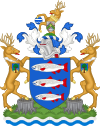Seething Wells
| Seething Wells | |
|---|---|
 Seething Wells old waterworks buildings from the A307 | |
| OS grid reference | TQ173674 |
| London borough | |
| Ceremonial county | Greater London |
| Region | |
| Country | England |
| Sovereign state | United Kingdom |
| Post town | SURBITON |
| Postcode district | KT6 |
| Dialling code | 020 |
| Police | Metropolitan |
| Fire | London |
| Ambulance | London |
| UK Parliament | |
| London Assembly | |
Seething Wells is a small locality of Surbiton close to the border with the Surrey District of Elmbridge.
Geography and history
Seething Wells is within the 0.23 km² Riverside South Conservation Area which was identified in 2003.[1] Its modern definition is any of the riverside tract of land previously used as a waterworks on the right (here south-east) bank of the Thames facing Grade I-listed Hampton Court Park. A slim portion away from the riverside was largely rebuilt into housing in the early 21st century while keeping a former pumping station building large enough to house steam engines to pump drinking water across much of London. Disused fresh water filter beds, over 2 metres below road level, are loosely under the control of Thames Water via subsidiary Kennett Homes.
The site borders lengthways the river and the residential streets in the conservation area. On its short sides it borders a multi-berth marina and a listed pub and passenger ferry.
The site's having a parkland and river half-panorama, less than a mile from Surbiton railway station led to a 2011-2014 application to convert the site to:
- publicly accessible nature reserve
- a replacement immediate riverside walk
- open space,
- A heritage and education centre
- a flood storage cell, river taxi drop off point, all to be enabled through the provision of a 92 berth leisure marina and lock gate
- 7 residential launch moorings,
- 64 homes set on a floating pontoon
- 300 sq metre restaurant
- ancillary space, associated landscape and parking.
The above was refused by the Royal Borough of Kingston upon Thames and (on appeal) by The Planning Inspectorate.[2] The Surbiton Filter Beds, exposed tunnels and half-open arches form a Metropolitan Open Area under successive London Plans to date. A labyrinth of underground tunnels and structures, some of which are statutorily listed, forms a habitat for eight species of bat including some of Britain's rarer varieties subject to special protection.[2]
The name is a gradual corruption of the original 'Siden Wells' which appears on maps from the 18th century, recorded as the medicinal spring at Soothing Wells in a time-of-construction guide to the South Western railway and its neighbouring countryside.[3] It denoted springs - reportedly warm springs of potable water.
The Metropolis Water Act of 1852 prohibited the extraction of water for household purposes from the tidal Thames (below Teddington Weir). The Lambeth Waterworks Company anticipated this by building their works at Seething Wells which were completed and opened in 1852, the same year as the Act was passed. Another company - the Chelsea Waterworks Company - joined the Lambeth Waterworks Company here. The two establishments existed side by side until they were both incorporated into the Metropolitan Water Board in 1903. However the inlets here sucked up too much mud with the water because of turbulence caused by the sharp bend, the twin-mouthed River Mole and The Rythe. The Lambeth Waterworks Company built its replacement installation at Molesey, and the Chelsea Waterworks Company followed them there three years later, after attempting to build works opposite Hampton Court.[4]
Seething Wells Kingston University halls of residence is on a small fraction of the former waterworks land.
See also
References
- ^ List of conservation areas - Riverside South Royal Borough of Kingston upon Thames. Retrieved 2015-03-02
- ^ a b APP/Z5630/A/13/2197943 Seething Wells Filter Beds Appeal Decision The Planning Inspectorate. Republished by the Royal Borough of Kingston. Retrieved 2015-03-02
- ^ Wyld's South Western London and Southampton Railway Guide Portsmouth, Isle of Wight and the Channel Islands...containing a topological...account of the country and of the towns and villages within 10 miles of the railway Publ. W. Clowes and Sons, London, 1839 Retrieved 2015-03-02
- ^ A Guide to the Industrial Archaeology of the Borough of Elmbridge



